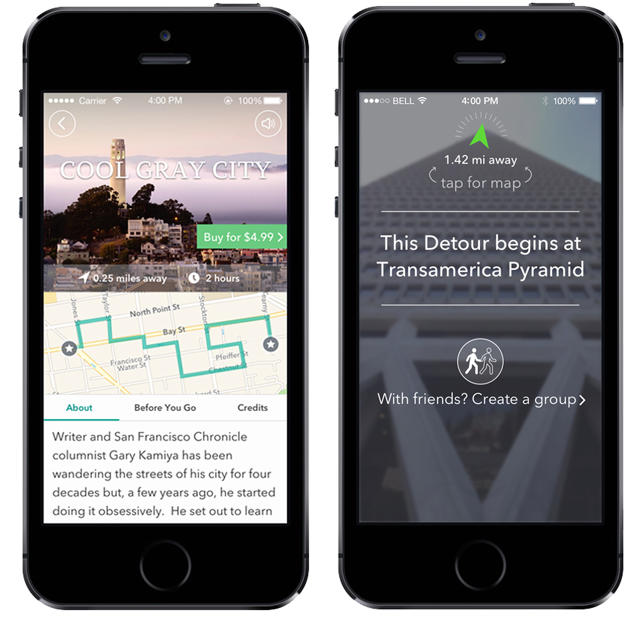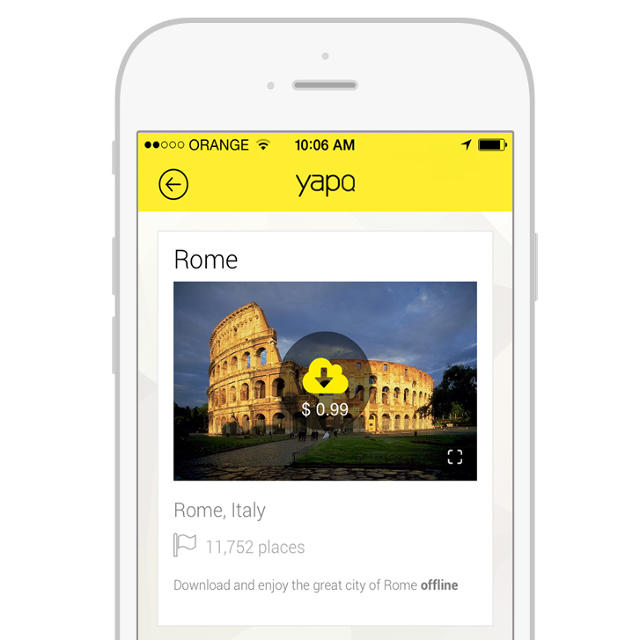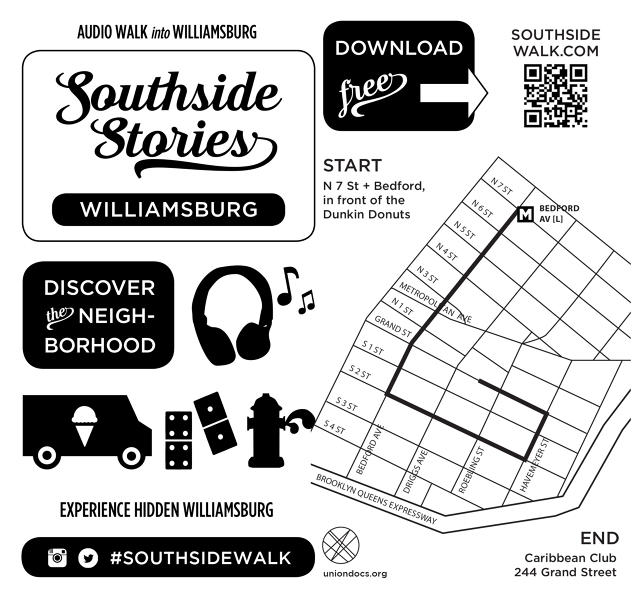While many still associate audio tours with bulky headsets rented from museum ticket counters, commercial startups, artists and storytellers are developing new smartphone-based urban audio walks they say can be as immersive as popular podcasts like Serial and This American Life.
Audio tours have the potential to change how tourists and locals alike experience cities, introducing listeners to landmarks and local stories they wouldn't otherwise stumble upon. But keeping listeners engaged as they stroll through busy city streets, smartphone in hand—and turning them into repeat customers, important since the startups make money on a pay-per-tour or subscription model—poses a significant design challenge: Producers must work to craft intriguing routes and make sure listeners don't have to rush or linger too long to stay in sync with the audio content.
Audio Tours Of All Stripes
Some of these walking tours rely on the smartphone simply as a portable audio player, guiding listeners on a fixed path through the sites and sounds of a particular neighborhood. Others, like those from Detour, an audio walk startup cofounded by former Groupon CEO Andrew Mason that had its public launch earlier this month, take advantage of more of the phone's capabilities, checking the phone's GPS coordinates to know when to play and pause, or using Bluetooth to let friends listen to the same tour at the same time. Another app, called yapQ, even integrates computer-spoken descriptions from untold numbers of geocoded Wikipedia pages so it can offer auto-generated audio tours around the world.
Clik here to view.

The Business of Audio Tours
"We just bet our company on the TTS technology—it's called text-to-speech," says YapQ cofounder Yossi Neiman. "You can download a whole city like London with 50,000 [points of interest], and it just works."
YapQ's iPhone and Android apps offer downloadable tours of cities around the world for $1 each, with machine-curated content about each city's sights available in multiple languages. While the audio is still noticeably machine-read, Neiman says the company is betting that within a couple of years, technology will make that much less noticeable, giving the company the edge over other audio tour creators who can only write and record descriptions of so many places.
"The advantage is huge," he says. "The other companies that do audio can squeeze in 40, maybe 50, points of interest."
Detour, on the other hand, offers only a handful of what might be called artisanal audio tours, currently each available for $4.99 or as part of an all-you-can-listen subscription for $19.99 per year. Mason says he's had the idea for the company for the better part of a decade but smartphone geolocation capabilities have only recently gotten good enough to avoid annoying glitches. "When we try using Detour on phones that are pre-iPhone 4, the GPS is so unreliable that it just results in a very buggy experience," he says. "When you add on top of that things like iBeacon and the sensors built into the iPhone, it gives us the kind of raw material that we need in order to really precisely locate people and create the experience that it feels like there's someone there with you."
Clik here to view.

A Feat Of Interactive Design
For high- and low-tech approaches alike, creators say the modern audio walk is a unique medium that combines the elements of radio storytelling with techniques more commonly used by people building websites and mobile apps. "It's not really just radio production that you need the skills to make a sound walk—it's really interactive design," says Shannon Carroll, project director for southside Stories, an audio tour of the historically Latino but rapidly changing Southside of Williamsburg, Brooklyn.
Audio walk creators have to think carefully about the paths they want their listeners to take and make sure stops at points of interest aren't so long that listeners get restless, Carroll says. They have to record and edit interviews with neighborhood residents or other experts to correspond to what listeners are seeing, and mix in ambient sounds in a way that keeps them engaged in the story, not distracted or unnerved by sounds like honking horns, she says. Here are the key ingredients for designing a great audio tour:
Clik here to view.

Interview Subjects In Their Native Environment
"When someone's interviewing someone about a story, I think doing it more in a This American Life style of interviewing is interesting—where you try to get the interviewee to show the story, not just tell it," she says. "Interview them on the street where the story is taking place, and have them point out and call out specific references."
Clik here to view.

Talk To The Locals
Getting knowledgeable locals to speak is important, especially when tours take listeners outside of traditional tourist areas, Mason says. His company has released a number of tours of San Francisco, including some that look at places and stories often not seen in tourist-frequented areas like Chinatown and Fisherman's Wharf, and some going slightly more off the beaten path, like a tour of the Tenderloin narrated by Electronic Frontier Foundation founder and Grateful Dead lyricist John Perry Barlow. "When we can find someone who's part of the community, we find them telling stories is more compelling than a reporter," Mason says. "If we're going to Chinatown or we're going to do the Haight, or something like that, it feels like those places should be narrated by people who are parts of those communities."
Timing Is Everything
Snippets of audio have to be timed to routes to avoid silence as listeners move from one location to the next location. You also don't want them to have to stop and stand in one place for too long. "So [if] it takes three minutes to walk down this block, that means that this story that I want to tell can only be three minutes," says Pejk Malinovski, who created Passing Stranger: The East Village Poetry Walk, a downloadable tour narrated by filmmaker Jim Jarmusch.
With a GPS-based system like Detour, that gets a little easier, since the app can insert or remove extra content to match the listener's steps, or provide extra directional guidance.
"If they're moving too fast, we cut can intelligently cut the narrator short," Mason wrote on the company blog. "If they get off track, we can insert a navigation sentence in the middle of the story. We also play subtle navigation cues—like the sound of footsteps—to give the user confidence that they're doing the right thing."
Keep Features To A Minimum
Audio tours should be as seamless as possible. You want users listening to your tour, and learning about a city in new ways, not fumbling through endless phone menus. "We want to make our product similar to the experience you have with a real person," says YapQ's Neiman. "He doesn't give you something to read—he talks to you, and you listen."
YapQ includes text, along with photos to help listeners identify attractions, but the Israel-based company aims to keep the interface as simple and immersive as possible, Neiman says: "When you start creating and using different UIs and buttons to press, you just get challenged." Mason concurs. "We think with interacting with the phone as a garnish on the experience is something that can be really cool from time to time," he says. "But we think for the most part it's better when the phone is in your pocket, the technology melts away and it's just you in the world getting the lightly guided experience from the audio stream, and you're not thinking about your phone."
Clik here to view.

What's Next
As Detour expands beyond its home base in San Francisco—Mason says tours in Austin, Los Angeles, New York, and Chicago are likely to be seen soon—it also plans to release authoring tools letting users build and share their own tours. They could time audio segments to walking paths and trim audio by editing a linked written transcript in a tool the company has under development. "We're trying to reduce the learning curve and make it as simple as writing a blog post," he says. "I think the world's going to be a lot more interesting when it's not just us creating Detours but Detour as a platform for creativity."
Clik here to view.

The exact business model is yet to be determined, including questions of quality control, but ultimately Mason hopes to build Detour into something like an iTunes for audio tours. "At the highest level, we want to make it possible for anyone to create and sell their own Detours, and get kind of a thriving ecosystem going," he says.